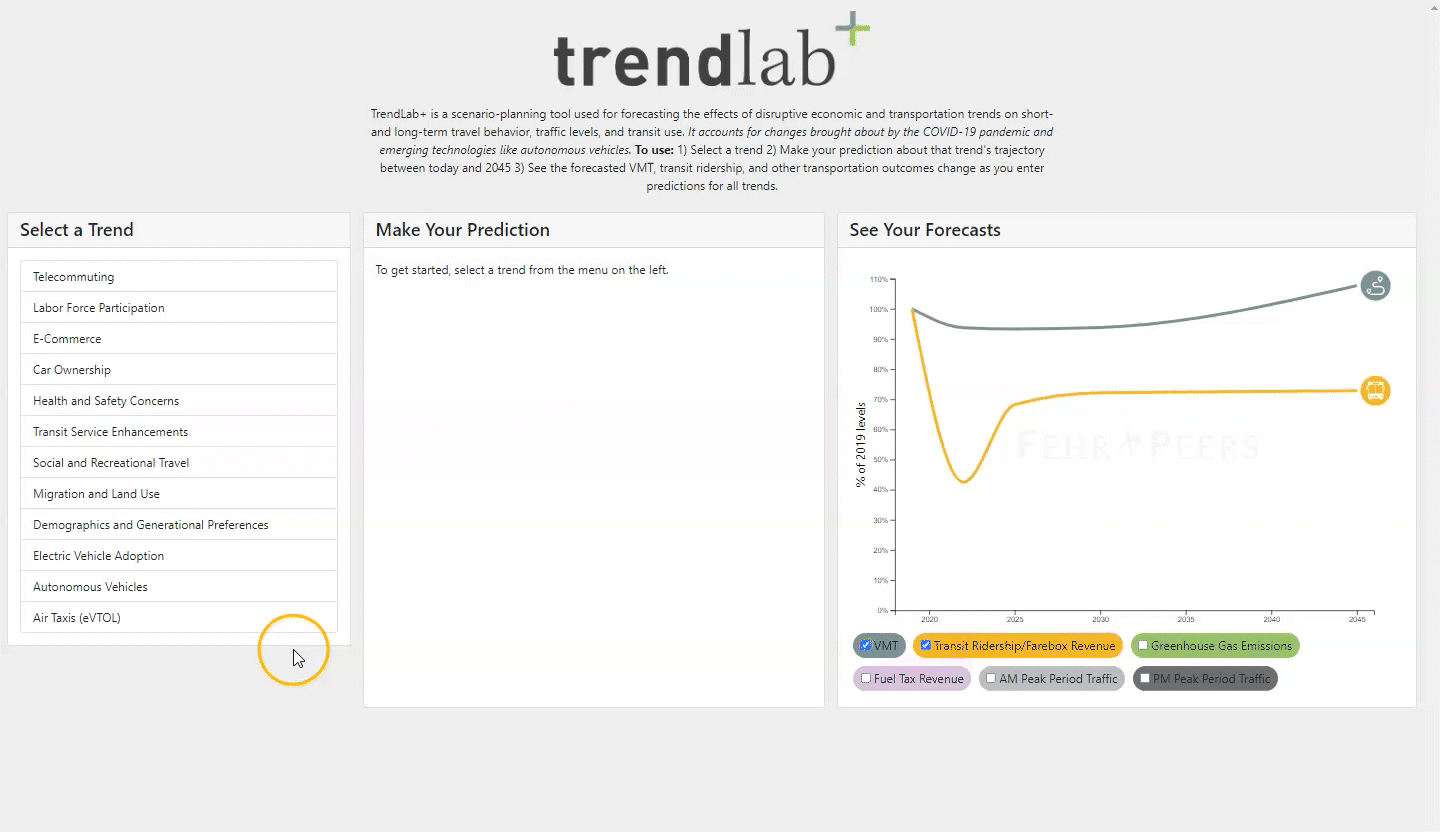
Scenario Planning for Pandemic Recovery and Beyond
Updated: March 2023
TrendLab+ is a scenario-planning tool designed by our FP Think initiative for forecasting the effects of emerging economic and transportation trends, including changes brought about by the COVID-19 pandemic, shifting consumer preferences, and new transportation and communications technologies.
TrendLab+ has been used for clients across the US in presentations, workshops, and project analyses, including transit recovery scenario testing, perspective setting for regional transportation plans, and community-level policy assessments.
Users can test various factors, such as levels of telecommuting, delivery services, urban migration, and the ability of transit agencies to recover lost ridership, to see what “new normal” they may produce in short-term, medium-term, and long-term scenarios. Doing so provides information to help formulate local and regional plans and identifies factors that may be beyond the immediate control of planning agencies, in order to help guide policies and actions that respond to their impacts.
During our recent 2020 Short Range Transit Plan process, Fehr & Peers’ TrendLab+ tool helped us model how different variables will impact transit ridership recovery in the coming years – this has helped set expectations for how long ridership will take to recover to 2019 levels.
Chris Lubbers, Transit Director: Summit Stage, Summit County Colorado
What are the Features of TrendLab+?
TrendLab+ includes a number of key features and innovations, including the following:
Dynamic User Interface
A web-based interface to view outputs in real time, on both an absolute and per capita basis
Latest Research
Background information on recent developments related to transportation trends, surveys on future expectations, along with the range of forecasts of their potential future trajectories
Customization
Capabilities to customize tool data and layouts to reflect local conditions or different performance metrics
Effects of 12 Key Trends
The ability to evaluate the effects and interactions of a dozen key trends including:
-
- labor force participation and telecommuting
- home shopping and deliveries
- shifting generational preferences, car ownership
- on-line activities versus social/recreational travel
- transit service changes, and lingering transit-use hesitancy
- shifts toward suburbanization
- new technologies including electric vehicles, autonomous vehicles and air taxis
Varying Time Horizons
The ability to look at travel over the next 5, 10, and 30 years to provide both short- and medium-term time horizons
Variety of Transportation Metrics
Including changes in vehicle miles traveled, transit ridership, traffic peaking and congestion, GHF impacts, fuel tax revenues, and disparate impacts on disadvantaged communities
Counter Strategies
The ability to consider proactive countermeasures in response to expected trends
User-Envisioned Scenarios
Three optional perspectives on each trend: return to pre-pandemic conditions, “new status quo” extending trends that have established themselves in 2023, and “transformative trends” under which recent disruptions establish new trajectories of travel behavior and transportation impacts
I highly value tools like TrendLab for scenario planning, since it allows regional agencies like WRCOG to quickly and easily evaluate different scenarios in real time. With a future that is becoming increasingly uncertain, TrendLab+ lets us engage in meaningful dialogue with our decision-makers and stakeholders to discuss what might happen in a thoughtful way.
Chris Gray, Deputy Executive Director, Western Riverside Council of Governments
What Are We Learning?
Vehicle Miles Traveled
VMT continues to increase with commute trips replaced by trips for other purposes. As working from home shifts to hybrid-work, traffic levels will continue to increase at rates greater than pre-Covid. Availability of autonomous vehicles will, over the long term, further increase VMT growth, while air taxi impacts will be minimal.
Consequences
Under most scenarios, VMT, congestion levels and GHG emissions will continue to increase at accelerated rates as preferences established during Covid inhibit transit recovery.
Countermeasures
Even with sustaining levels of working from home and hybrid work, VMT impacts are likely to increase above pre-COVID levels unless countermeasures are applied through pricing and other disincentives and through investments in alternative modes.
Transit Ridership
Transit use was declining even before Covid and is rebounding slowly from the effects of Covid. Particularly for commuter services oriented toward downtowns with low levels of return-to-office, additional funding support is likely to be needed from Federal and local sources to restore transit service levels and rider confidence.
Consequences
It will take longer for some transit agencies to recover to previous ridership levels. In addition to continued levels of telecommuting, suburban migration and mode choice habits established during COVID create pessimistic scenarios in which some transit agencies may not fully recover until beyond 2030.
Countermeasures
In addition to new funding sources to sustain service levels through a slow recovery, agencies will benefit from proactive measures to re-think service patterns, ensure safety, and attract riders.
Disparate Impacts
Many of the trends that have arisen since Covid have had disproportionally adverse impacts on socially and economically disadvantaged communities and individuals.
Consequences
While higher income individuals and non-essential workers have been able to reduce their need to travel, those in lower income job categories have continued to have a high need to travel and have had reduced ability to travel due to reductions in transit service or related concerns about health and safety.
Countermeasures
Restoring high levels of transit service and overcoming concerns about personal health and safety accessing and using transit will be essential to minimizing disparate impacts on accessibility to jobs, goods and services.
As the Presidio Trust plans for its transportation systems in a post-pandemic environment, we are using TrendLab+ to estimate the rate and magnitude of changing use patterns and more strategically allocate resources.
Amy Marshall, Transportation Manager, Presidio Trust
Contributors

Matt Haynes
FP Think Initiative Leader


